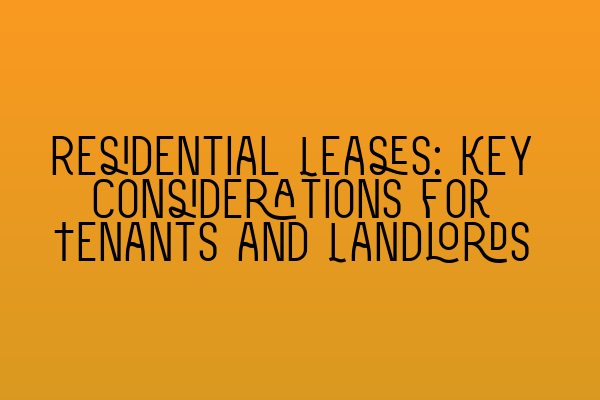Residential Leases: Key Considerations for Tenants and Landlords
When it comes to renting a residential property, both tenants and landlords have important considerations to keep in mind. Residential leases outline the rights and responsibilities of both parties, and understanding these key considerations is crucial to ensuring a smooth and harmonious tenancy. In this blog post, we will explore some of the essential elements that tenants and landlords should be aware of when entering into a residential lease agreement.
1. Clear and Comprehensive Lease Agreement
A well-drafted lease agreement is the foundation of a successful tenancy. It should clearly outline the terms and conditions of the tenancy, including the duration of the lease, the rent amount and payment terms, any additional charges or fees, and the responsibilities of both the tenant and the landlord. It is vital to carefully review the lease agreement before signing it and seek legal advice if needed.
2. Rent and Deposit Payments
Rent is a critical consideration for both tenants and landlords. Tenants should understand their obligations regarding monthly rent payments and any late fees that may be imposed. It is also essential to clarify the method of payment, whether it be by check, bank transfer, or another accepted form of payment. Landlords should clearly communicate their expectations regarding rent payment and provide tenants with a receipt for each transaction. Additionally, landlords may require tenants to pay a security deposit, which should be clearly stated in the lease agreement along with details of how and when it will be returned.
3. Maintenance and Repairs
The responsibility for maintenance and repairs is an important consideration in residential leases. Landlords should ensure that the property is safe, habitable, and in good condition before the tenant moves in. They are typically responsible for major repairs, such as structural issues or faulty electrical systems. However, tenants are generally responsible for minor repairs and day-to-day maintenance, such as changing light bulbs or keeping the property clean and tidy. It is crucial to clearly define these responsibilities in the lease agreement to avoid any misunderstandings.
4. Termination and Renewal
Both tenants and landlords should understand the terms and procedures for terminating a lease. The lease agreement should specify the notice period required by both parties and any penalties or consequences for early termination. Additionally, landlords may include provisions for lease renewal or rent increases at the end of the initial lease term. It is essential to review these terms carefully and negotiate if necessary.
5. Legal Compliance
Complying with relevant laws and regulations is essential for both tenants and landlords. Landlords should ensure they meet all legal requirements regarding property licensing, safety standards, and fair housing laws. Tenants, on the other hand, should familiarize themselves with their rights and responsibilities under local tenancy laws. It can be helpful to seek legal advice to ensure full compliance with all legal obligations.
Conclusion
Renting a residential property can be a positive and rewarding experience for both tenants and landlords, provided that both parties are aware of their rights and responsibilities. By ensuring a clear and comprehensive lease agreement, understanding rent and deposit payments, clarifying maintenance and repair responsibilities, familiarizing themselves with termination and renewal procedures, and complying with the law, tenants and landlords can establish a harmonious and successful tenancy.
If you’re preparing for the SQE exams, be sure to check out our related articles for SQE 1 practice exam questions, practice mocks for FLK1 and FLK2, SQE 2 preparation courses, SQE 1 preparation courses, and SRA SQE exam dates.
[Source: SQE Property Law & Land Law – Residential Leases: Key Considerations for Tenants and Landlords]
